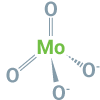



Molybdenum
(Mo)
The availability of molybdenum differs from other trace elements in relation to soil pH. It is not available in acidic soil but becomes very soluble and can be mobilised in alkaline soil. The required quantities are very low and precision and moderation is needed when applying.
Unlike other trace elements, molybdenum is strongly bound to iron and therefore unavailable in acidic soils. As pH rises, molybdenum becomes mobile and its availability increases significantly. Fresh organic matter ensures a good supply of Mo. This is not the case for peat, which develops under acidic conditions. The graph shows the different forms of Mo depending on the pH value of the soil. It shows that the MoO42- content (the form which is taken up by plants) increases significantly as pH rises.
Very
Fairly
Moderately
| Mo | ||
|---|---|---|
| Cabbage | ||
| Lettuce | ||
| Spring Barley | ||
| Sugar Beet | ||
| Tomato | ||
| Winter Barley | ||
| Winter Rapeseed | ||
| Cherries | ||
| Carrot | ||
| Cucumber | ||
| Apple | ||
| Grape Vine | ||
| Pear | ||
| Grain Maize | ||
| Silage Maize | ||
| Potatoes | ||
| Strawberry | ||
| Tomato | ||
| Fiber Flax | ||
| Sunflower | ||
| Winter Wheat |
Mo deficiency is often linked to nitrogen deficiency in legumes. Since Mo is necessary for the activity of nitrogenase and the fixation of N2, an N-deficiency can be observed. On crucifers, interveinal chlorotic plaques appear on the leaves, with a greyish colour and a soft consistency. In the most severe cases, the leaves of the plants are completely deformed.
Excess molybdenum blocks copper and may induce deficiencies in cereals and fodder grasses. Acidophilic crops, such as rubber, are sensitive to any excess of molybdenum.
The soil content varies greatly depending on the source rock, the iron content and the level of acidity. In general, assimilable Mo is higher in alkaline soils, soils rich in organic matter and young soils derived from volcanic rocks, whereas soils rich in iron have low Mo contents.
LAT Nitrogen Austria GmbH
St.-Peter-Strasse 25
4021 Linz, Austria
















